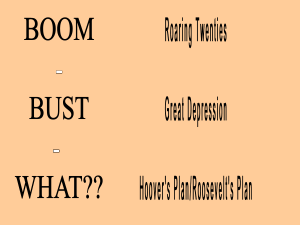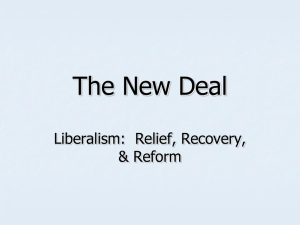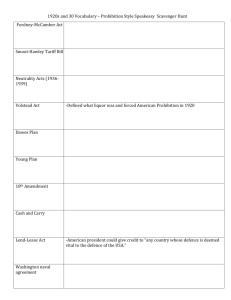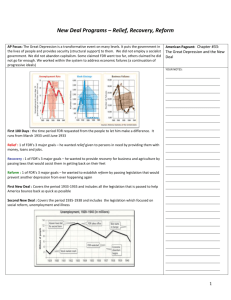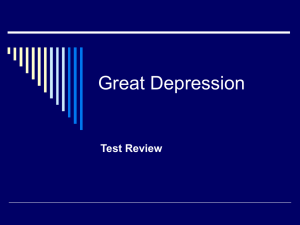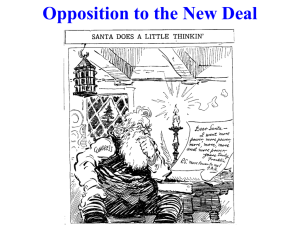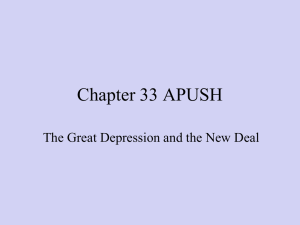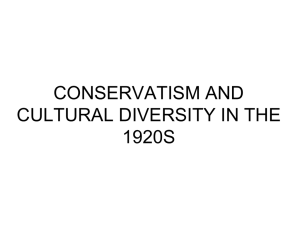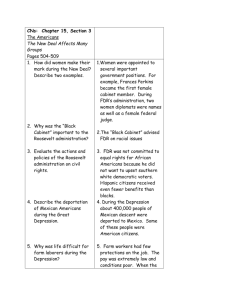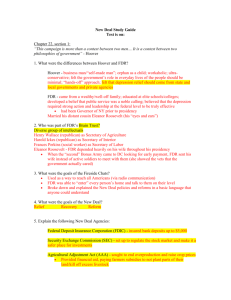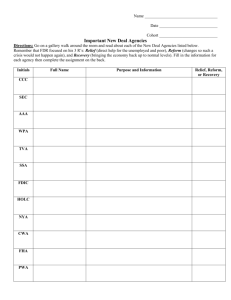Lecture # 7 The Great Depression, 1929 to 1941 INTRO: By 1929
advertisement
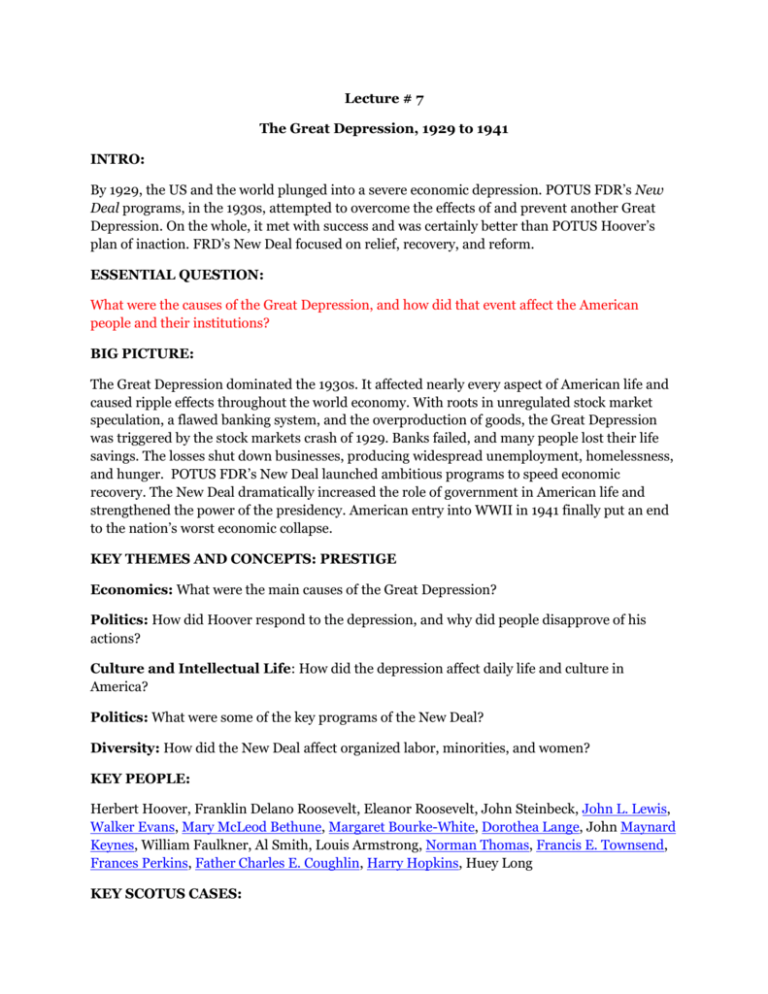
Lecture # 7 The Great Depression, 1929 to 1941 INTRO: By 1929, the US and the world plunged into a severe economic depression. POTUS FDR’s New Deal programs, in the 1930s, attempted to overcome the effects of and prevent another Great Depression. On the whole, it met with success and was certainly better than POTUS Hoover’s plan of inaction. FRD’s New Deal focused on relief, recovery, and reform. ESSENTIAL QUESTION: What were the causes of the Great Depression, and how did that event affect the American people and their institutions? BIG PICTURE: The Great Depression dominated the 1930s. It affected nearly every aspect of American life and caused ripple effects throughout the world economy. With roots in unregulated stock market speculation, a flawed banking system, and the overproduction of goods, the Great Depression was triggered by the stock markets crash of 1929. Banks failed, and many people lost their life savings. The losses shut down businesses, producing widespread unemployment, homelessness, and hunger. POTUS FDR’s New Deal launched ambitious programs to speed economic recovery. The New Deal dramatically increased the role of government in American life and strengthened the power of the presidency. American entry into WWII in 1941 finally put an end to the nation’s worst economic collapse. KEY THEMES AND CONCEPTS: PRESTIGE Economics: What were the main causes of the Great Depression? Politics: How did Hoover respond to the depression, and why did people disapprove of his actions? Culture and Intellectual Life: How did the depression affect daily life and culture in America? Politics: What were some of the key programs of the New Deal? Diversity: How did the New Deal affect organized labor, minorities, and women? KEY PEOPLE: Herbert Hoover, Franklin Delano Roosevelt, Eleanor Roosevelt, John Steinbeck, John L. Lewis, Walker Evans, Mary McLeod Bethune, Margaret Bourke-White, Dorothea Lange, John Maynard Keynes, William Faulkner, Al Smith, Louis Armstrong, Norman Thomas, Francis E. Townsend, Frances Perkins, Father Charles E. Coughlin, Harry Hopkins, Huey Long KEY SCOTUS CASES: Schechter Poultry Corporation v. US (1935) (NRA declared unconst); US v. Butler (1936) (AAA declared unconst. Agriculture was a local, not interstate matter under the 10th Amendment) A. ONSET OF THE GREAT DEPRESSION 1. Weaknesses in the Economy a. Overproduction/underconsumption (maldistribution of wealth: gap) b. Overexpansion of credit (buying on the margin) 2. The Stock Market Crash a. Worldwide nature due to growing financial interdependence b. Interdependent banking systems c. International trade d. Political repercussions 3. The Hoover Response a. Rugged individualism: “trickle down” economics b. Reconstruction Finance Corporation (RFC) 4. Unemployment, the Bonus Army, Hoovervilles; impact on women and minorities B. FDR’S NEW DEAL: RELIEF, RECOVERY, AND REFORM PROGRAMS STAGES OF THE NEW DEAL 1. 1933-early 1935: ND legislation dealt with relief and recovery. Much of this legislation was passed in the “First Hundred Days’ after FDR took office in March 1933. The 1934 Congressional elections increased the size of the Democratic majority in each house, which helped the ND legislative effort. 2. 1935 and early 1936: Often called the “Second Hundred Days” or the “Second New Deal,” this period’s legislation focused more on social reform. 3. 1936 election: This year is considered the turning point of the ND. 4. 1937-1938: A recession led to a new collapse in the weak economy that had just been starting to improve. The recession was due in part to ND cutbacks in spending after the 1936 election. 5. 1938: By 1938, the ND had ended due to increased opposition in Congress and preoccupation with the danger of world war. Unemployment did not improve significantly until WWII created jobs in the production of war goods. 1. Relief of human suffering (to aid those suffering) a. Emergency Banking Act (Bank “Holiday”) (1933) b. Federal Emergency Relief Act (1933) c. Unemployment: PWA (1933), CCC (1933), WPA (1935), TVA (1933) 1) Troubling gender/racial equity issues 2. Recovery of the US Economy (so it can grow) a. NRA: “set codes of fair competition” with businesses to maintain prices, minimum wages, and maximum hours. Unpopular and unconst. (1935) b. Home Mortgage relief: HOLC (1933), FHA (1934) c. First AAA (1933; unconst in 1936), Second AAA (1938): farm prod/price regs 3. Search for effective reform: program examples (to avoid future depressions) a. Banking: Glass-Steagall Act, 1933 (FDIC) b. Stock Market: Securities and Exchange Commission, 1934 (SEC) c. Elderly/Disabled: Social Security Act, 1935 (insurance & public assistance program) d. Labor: 1) National Labor Relations Act, 1935 (Wagner Act) 2) Fair Labor Standards Act, 1938 (min wage/child labor) 4. Labor’s response: Formation of CIO (Congress of Industrial Organizations) 5. Controversial aspects of the New Deal a. Constitutional issues 1) SCOTUS and the NRA (Schechter Poultry Corp. v. US, 1935) 2) SCOTUS and the AAA 3) TVA: Model yardstick or creeping socialism? b. 1936 election “FDR’s mandate” c. FDR’s Judicial Reorganization Bill: aka “Court-Packing” Proposal 1) Failure and Success d. 1940: 3rd Term controversy (the unwritten constitution) e. Passage of the 22nd Amendment (1951) f. Critics of New Deal (but not always of FDR) 1) See chart Women and AAs ND programs offer more opportunities to white men than to women and minorities. Women and AAs are paid less for the same work. Progressives & Socialists ND programs are not doing enough to solve the nation’s problems. More should be done to distribute the nation’s wealth among all Americans Republicans & others Government is taking on too much responsibility and becoming too powerful. FDR is like a dictator. ND taxes on the wealthy are unfair. ND programs are too much like socialism. 6. The Human Factor a. FDR as first rate communicator and his efforts to restore public confidence; press conferences, “fireside chats,” effective use of the radio, hide paralysis. b. Eleanor Roosevelt as the President’s eyes and ears c. The Dust Bowl and the “Okies” d. The New Deal and women (Frances Perkins) e. The New Deal and minorities (shift in AA vote): discriminatory results f. Indian Reorganization Act (1934) 7. Culture and the Depression a. Literature: John Steinbeck and Langston Hughes b. Music: jazz, swing (big band) c. Art: WPA, fine arts, Hollywood, comic books 8. Opposition to the New Deal: a. Al Smith, Norman Thomas, Huey Long, Father Coughlin, Dr. Townsend C. EVALUATING THE NEW DEAL 1. Most historians agree on the following assessment of the New Deal: a. WWII was largely responsible for ending the GD. The ND did not solve unemployment, the farm crisis, or underconsumption. b. Nevertheless, the ND did help people cope with the effects of the GD. c. The ND brought more power to the presidency and to the federal government. The government now had a role and a responsibility in more aspects of the nation’s economic social life. d. The ND preserved the free-enterprise system. 2. Reaction? a. “Roosevelt is only President we ever had that thought the Constitution belongs to the poor man, too.” George Dobbin, mill worker, 1939.
